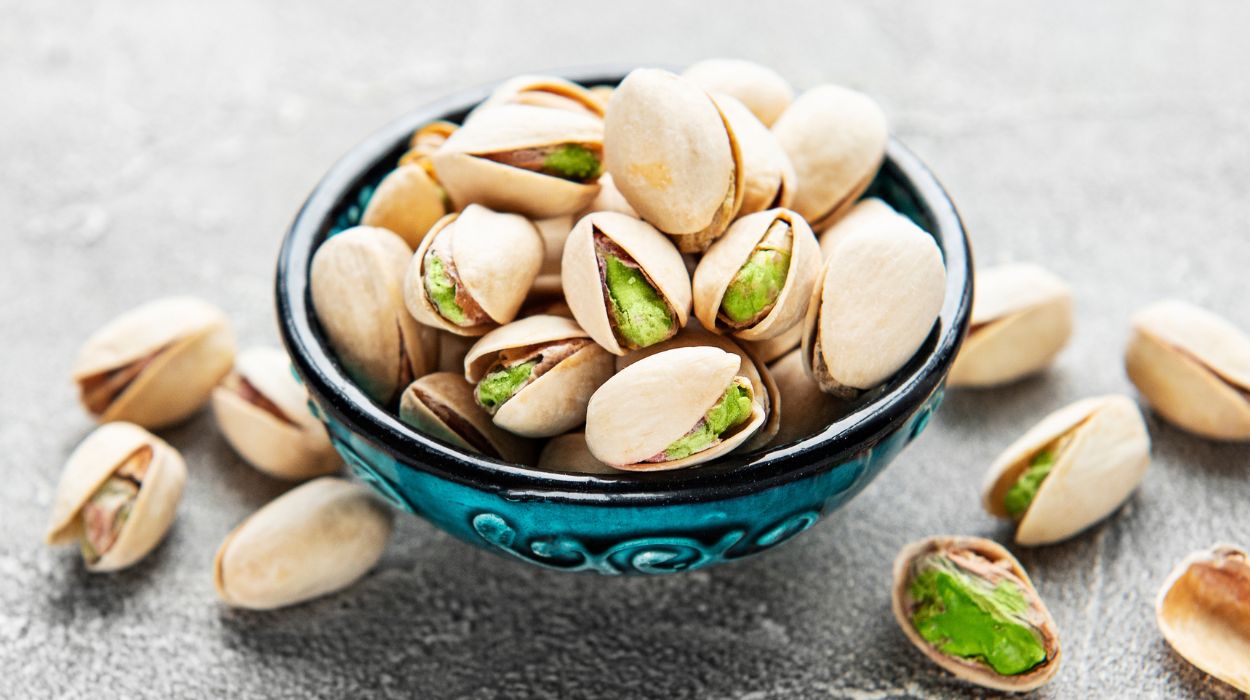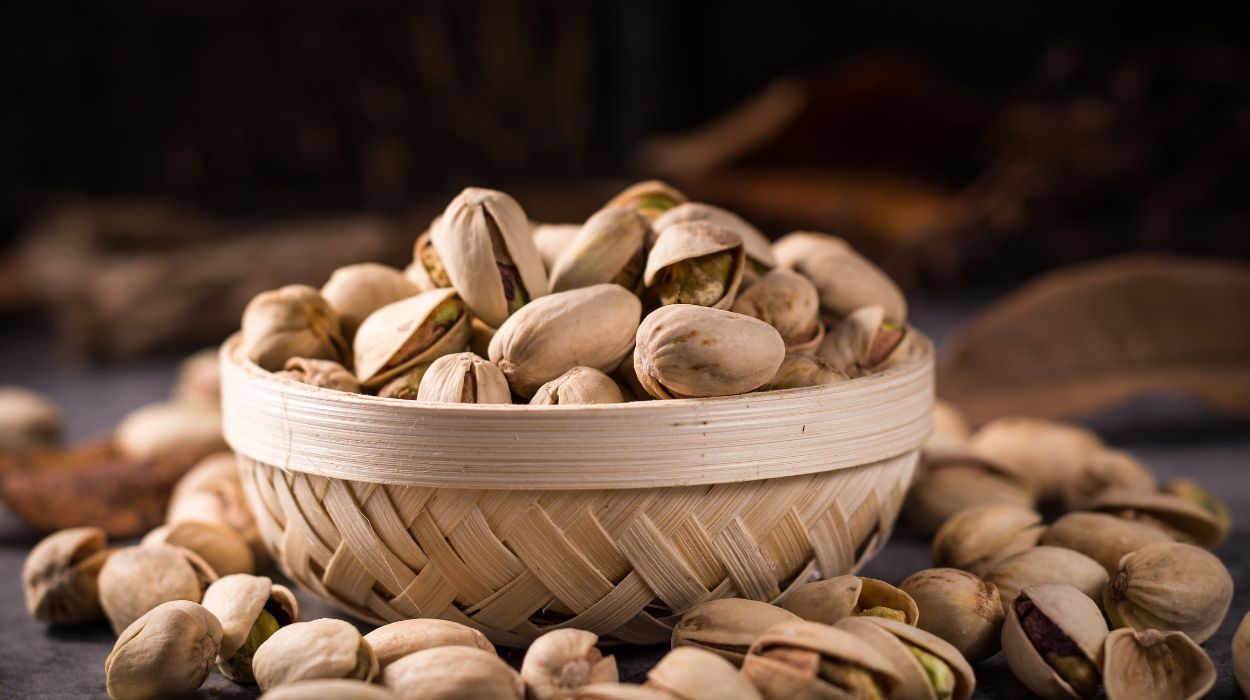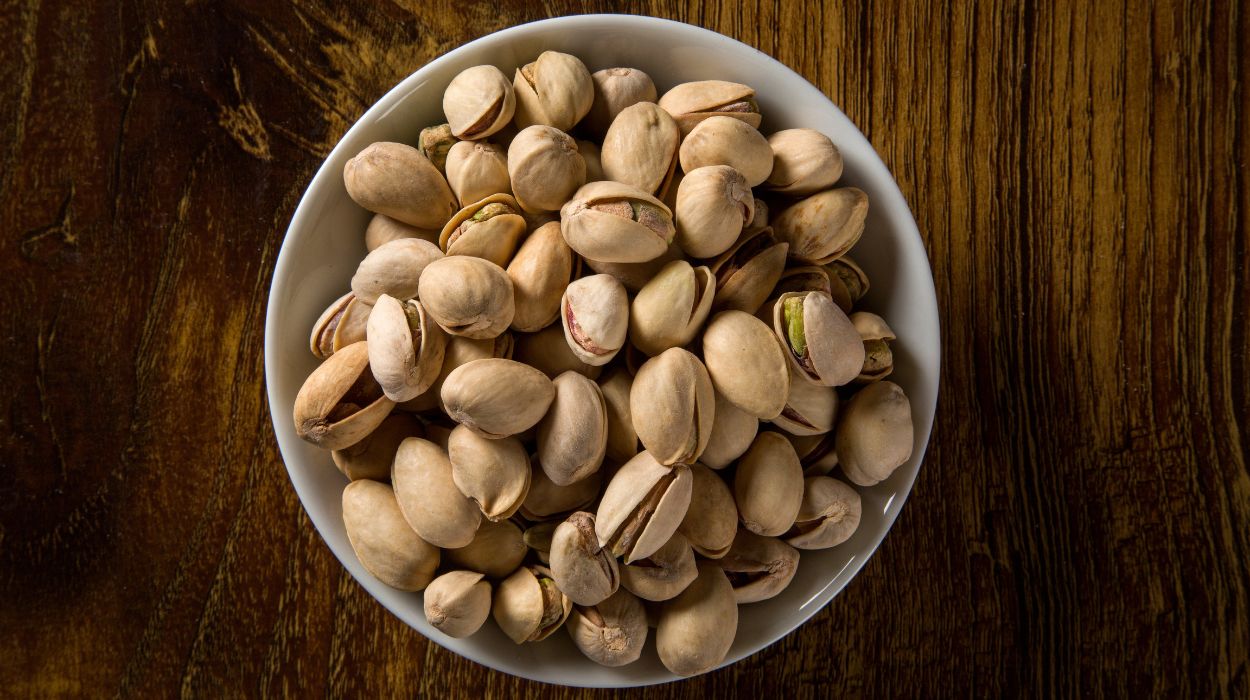 Evidence Based
Evidence Based
Evidence Based
This article is objectively based on relevant scientific literature, written by experienced medical writers, and fact-checked by a team of degreed medical experts.
Our team of registered dietitian nutritionists and licensed medical professionals seek to remain objective and unbiased while preserving the integrity of any scientific debate.
The articles contain evidence-based references from approved scientific sites. The numbers* in parentheses (*1,2,3) will take you to clickable links to our reputable sources.
Are Pistachios Good For You? Health Benefits, Nutrition & Risks 2024

Pistachios are the nut of the pistachio tree native to Iran and a traditional part of cuisine in the Middle East and Mediterranean region. Pistachio consumption has grown exponentially, and so has agricultural production in the U.S. If you’ve wondered whether pistachios are good for you, we can help settle the debate.
Pistachios contain high amounts of polyphenols, fiber, protein, and healthy fats. Within the context of a healthy diet, pistachios can benefit heart health, gut health, weight loss, and reduce inflammation through powerful antioxidants.
7 Amazing Health Benefits Of Pistachios
Here are some of the key health benefits associated with pistachio nuts:
- Help lower blood pressure
- Antioxidants
- Improve blood sugar
- Support gut health
- Support healthy cholesterol levels
- Antiviral & antimicrobial
- Aid weight loss
Health Benefits Of Pistachios

The health benefits[1] of pistachio nuts are broad and rooted in their nutritional value and wealth of bioactive compounds. Let’s delve into why pistachios are good for you.
Help Lower Blood Pressure
Pistachios are rich in both potassium and magnesium, important nutrients that help lower blood pressure. Potassium acts as a counterbalance to sodium, which can increase blood pressure if consumed excessively. Potassium encourages sodium excretion, so a high-potassium diet will help negate sodium intake. Potassium also helps ease the tension on your vessel walls to lower blood pressure overall by reducing vascular resistance.
One serving of pistachios contains about 6% of your daily recommended potassium. Along with other potassium-rich foods, such as tomatoes, potatoes, leafy greens, and low-fat dairy, eating pistachios daily can reduce blood pressure and improve circulation.
Magnesium plays a similar role in relaxing blood vessels and improving blood flow. The magnesium in a serving of pistachios is about 8% of recommended needs!
The significant dose of potassium and magnesium in pistachios is a powerful addition to a healthy diet. Even if you don’t have high blood pressure, eating a diet high in these minerals will help prevent high blood pressure down the road.
Antioxidants
Phytochemicals are compounds found in fruits vegetables, and other plant foods that have health benefits. Pistachios contain high amounts[2] of many different flavonoids, a class of phytochemicals. In fact, they have the highest concentration of flavonoids among most nuts.
Phytochemicals and compounds such as gamma-tocopherol (𝛾-tocopherol) and carotenoids can act as antioxidants and benefit a variety of functions in the body. The anti-inflammatory effects of phytochemicals in pistachios have been investigated against various conditions.
For example, the antioxidant power of pistachios may play a part in cardiovascular health. Many studies have observed[3] lower oxidized LDL in the blood with pistachio consumption and lower total blood lipids along with preventive effects against endothelial dysfunction. This is hypothesized to be a result of the bioactive compounds found in this nut.
The anti-inflammatory effects of the antioxidants can also benefit skin health. One study found protective effects[4] of pistachios against the damaging effects of UV light. Further research is still emerging in this space.
Improve Blood Sugar
Studies[5] have also shown that eating pistachios as part of a healthy diet can support healthy blood sugar levels.
The nutrition profile of pistachios is naturally conducive to helping blood sugar control. They are a low carbohydrate food while also high in protein and healthy fats. This equates to a limited rise in blood sugar after eating a meal or snack that contains pistachios.
Research also reveals that pistachios’ phytochemicals may positively impact several enzymes that regulate blood sugar. These plant compounds may be slowing the digestive breakdown of carbohydrates or inhibiting[6] the absorption of sugar, both of which would decrease the risk of blood sugar spikes.
Support Gut Health
For a small package, the fiber content of pistachios is mighty. One serving provides about 3 grams of fiber or 10% of the recommended daily intake (RDI). Increased dietary fiber intake from foods such as pistachios will support a healthy digestive system.
The fiber in pistachios will soften stools and facilitate transit. Reducing the risk of constipation will benefit your overall gut health and even prevent conditions such as hemorrhoids or diverticulosis.
There is also research on the benefits of nuts on the gut microbiome.[7] A randomized cross-over feeding study[8] investigated the effects of pistachio and almond consumption on gut microbiota. Pistachios increased the presence of beneficial gut bacteria, an effect that was much stronger than what was observed with almond consumption.
These studies and others demonstrate that the fibers in pistachios increase the presence of healthy gut bacteria. It is hypothesized the fibers likely act as a prebiotic,[9] which subsequently promotes the growth of healthy bacteria.
Support Healthy Cholesterol Levels
Eating pistachios has been linked to lower low-density lipoprotein ( LDL) cholesterol[3] and thus improvements in heart disease risk. The mechanisms are still being investigated, but there may likely be a few known factors.
The composition of polyunsaturated and monounsaturated fats in pistachios has significant research to support their action in supporting healthy cholesterol levels. The American Heart Association recommends replacing saturated fats with sources of unsaturated fat to improve cholesterol levels and lipoprotein profiles.
Second, the phytosterol content of pistachios[10] is the highest among all nuts, along with sunflower kernels. Phytosterols are bioactive plant compounds that are chemically similar to the cholesterol obtained from animal sources. It is hypothesized that phytosterols decrease cholesterol absorption and thus lower LDL cholesterol levels.[11]
While phytosterols from pistachios have been shown to lower cholesterol levels, the effects on overall cardiovascular risk are still mixed. However, recent studies show an inclination to use phytosterols as an effective tool in the war against cardiovascular disease.
Antiviral & Antimicrobial
A surprising benefit of pistachios may be their antiviral and antimicrobial properties.
Lab-based studies using polyphenol-rich extracts from pistachios have been tested against viruses such as herpes simplex virus[12] (HV-1) with remarkable protective results. Other research has shown protective effects from harmful bacteria such as staphylococcus.[13]
While you may get some of these benefits from consuming pistachios, human research would be needed to confirm. Currently, there is a potential role of extracts from pistachios as natural compounds for future drug development or as an application to deter bacterial growth in food.
Aid Weight Loss
When consumed as part of a diet pattern that facilitates a calorie deficit, pistachios may benefit weight loss efforts.
The high protein, fat, and fiber content of pistachios will leave you feeling full compared to the low-satiety of snacks high in refined carbohydrates. Pistachios are also relatively low in calories compared to most other nuts, so they are a great nut to choose on a calorie-controlled diet.
The benefits of pistachios on your blood sugar may also help reduce cravings and prevent overeating. Read on for some of the cautions associated with pistachios in a healthy diet.
Nutrition Value

Like many other nuts, these little green gems pack a ton of nutrition in a small package. They may take some effort to open, but you’re rewarded with a nutrient-dense treat.
One serving[14] of pistachios is 1 ounce or about 49 kernels, according to the United States Department of Agriculture (USDA). They are dense in fats, protein, potassium, magnesium, iron, Vitamin K, and Vitamin E.
The nutrition in one serving of raw pistachios is as follows:
- Calories: 159 calories
- Protein: 5.7 grams (g)
- Fat: 12.8 g
- Total Carbohydrate: 7.7g
- Fiber: 3 g
- Sodium: 0 milligrams (mg)
The fat composition[15] in pistachios is mostly unsaturated fat versus saturated fat. Furthermore, the unsaturated fat composition tips slightly towards more monounsaturated fat versus polyunsaturated fatty acids.
Pistachio nuts have good amounts of all nine essential amino acids which must be obtained from the diet as the body cannot produce them. This means the protein contained in the nuts is easily digested[16] and absorbed for optimal health benefits.
Of caution, a wide variety is sold with salt added, so the sodium content can vary greatly. Raw pistachios do not contain any naturally occurring sodium, but salted pistachios could contain several hundred milligrams of sodium. Recall that we should limit our daily intake of sodium to 2,300 mg for optimal heart health.
Potential Side Effects
There is some misinformation out there that pistachios are bad for your health. Pistachios, like all nuts, are calorie-dense and too much of a good thing is possible. Eating pistachios in oversized portions could set you back in your health goals by providing excessive calories and derailing your weight loss program.
A right-size portion of pistachios is one ounce, about a handful of nuts. Consuming too many pistachios may create an energy imbalance that will affect your weight maintenance or weight loss goals. The recommended portion size is 1 ounce based on USDA guidelines designed to meet nutritional needs.
Pistachios are a hefty source of fiber as well providing about 3 grams of fiber per ounce, so you could experience gastrointestinal (GI) discomfort if consumed in large portions in one sitting. Those with digestive conditions such as irritable bowel syndrome (IBS) may want to gradually introduce pistachios into their diet to allow their digestive tract time to adapt to a higher fiber intake, which is recommended in IBS patients.
Finally, pistachios are considered a tree nut and the allergy risk is higher than many other foods. Most individuals who are allergic to tree nuts have severe reactions to more than one nut. It is particularly common for a cashew and pistachio allergy[17] to occur together, for example.
So, use caution in consuming pistachios if you have a known tree nut allergy or a family history of nut allergies.
How To Eat Pistachios Properly
Pistachios can be purchased in the shell, or as kernels (shells removed). The de-shelled version is convenient for many different uses, but there may be some downsides to the shelled pistachios, such as ease of excessive consumption.
Some health experts recommend choosing to buy pistachios in the shell for a few reasons. The work of removing the shells for each bite will slow the eating process and may help prevent overeating. The act of removing the shells can be a form of mindful eating.
Furthermore, the discarded shells are a visual reminder of the amount consumed. A 2011 study[18] tested this theory. Subjects consumed almost 20% fewer calories when the shells were left as a visual reminder instead of being thrown away. Once again, in-shell pistachios may contribute to more mindful eating in the correct portions.
So, if you purchase the version in the shell, here are a few tips to safely remove the shells:
- Most pistachios sold commercially have a crack on the top of the shell. You can simply use your thumb to pry the shell open with usually not a lot of effort.
- If the crack is too thin to fit your thumb, try using a discarded shell to fit into a thin crack and twist to get the pistachio open. Or try a dull butter knife using the same technique.
- If you come across a fully closed shell, these can take a bit more effort, but don’t give up! Use a solid object (such as a can or jar in the kitchen) or the flat side of a knife and smash it open. It may take some practice to find the right amount of force without smashing the meat of the kernel too.
The Bottom Line
When consumed in the right size portion and as part of a balanced eating pattern, pistachios have a variety of benefits for overall health. These unique green nuts are both tasty and nutritious.
About a handful per day (or about 1 ounce) is the recommended serving to reap the benefits while still balancing energy intake. Consider choosing in-shell pistachios without added salt, or a lightly salted version for regular consumption.
+ 18 sources
Health Canal avoids using tertiary references. We have strict sourcing guidelines and rely on peer-reviewed studies, academic researches from medical associations and institutions. To ensure the accuracy of articles in Health Canal, you can read more about the editorial process here
- Mandalari, G., Barreca, D., Gervasi, T., Roussell, M.A., Klein, B., Feeney, M.J. and Carughi, A. (2021). Pistachio Nuts (Pistacia vera L.): Production, Nutrients, Bioactives and Novel Health Effects. Plants, [online] 11(1), p.18. doi:10.3390/plants11010018.
- Yuan, W., Zheng, B., Li, T. and Liu, R.H. (2022). Quantification of Phytochemicals, Cellular Antioxidant Activities and Antiproliferative Activities of Raw and Roasted American Pistachios (Pistacia vera L.). Nutrients, [online] 14(15), p.3002. doi:10.3390/nu14153002.
- Ghanavati, M., Rahmani, J., Clark, C.C.T., Hosseinabadi, S.M. and Rahimlou, M. (2020). Pistachios and cardiometabolic risk factors: A systematic review and meta-analysis of randomized controlled clinical trials. Complementary Therapies in Medicine, [online] 52, p.102513. doi:10.1016/j.ctim.2020.102513.
- International Journal of Food Sciences and Nutrition. (2017). Photoprotection by pistachio bioactives in a 3-dimensional human skin equivalent tissue model. [online] Available at: https://www.tandfonline.com/doi/abs/10.1080/09637486.2017.1282437
- Hadi, A., Asbaghi, O., Kazemi, M., Khadem, H. and Ghaedi, E. (2022). Effects of pistachios on glycemic control: A systematic review and meta-analysis of randomized controlled trials. British Journal of Nutrition, [online] pp.1–26. doi:10.1017/s0007114522002100.
- Lalegani, S., Ahmadi Gavlighi, H., Azizi, M.H. and Amini Sarteshnizi, R. (2018). Inhibitory activity of phenolic-rich pistachio green hull extract-enriched pasta on key type 2 diabetes relevant enzymes and glycemic index. Food Research International, [online] 105, pp.94–101. doi:10.1016/j.foodres.2017.11.003.
- Creedon, A.C., Hung, E.S., Berry, S.E. and Whelan, K. (2020). Nuts and their Effect on Gut Microbiota, Gut Function and Symptoms in Adults: A Systematic Review and Meta-Analysis of Randomised Controlled Trials. Nutrients, [online] 12(8), p.2347. doi:10.3390/nu12082347.
- Ukhanova, M., Wang, X., Baer, D.J., Novotny, J.A., Fredborg, M. and Mai, V. (2014). Effects of almond and pistachio consumption on gut microbiota composition in a randomised cross-over human feeding study. British Journal of Nutrition, [online] 111(12), pp.2146–2152. doi:10.1017/s0007114514000385.
- Scott, K.P., Martin, J.C., Duncan, S.H. and Flint, H.J. (2013). Prebiotic stimulation of human colonic butyrate-producing bacteria and bifidobacteria,in vitro. FEMS Microbiology Ecology, [online] 87(1), pp.30–40. doi:10.1111/1574-6941.12186.
- Phillips, K.M., Ruggio, D.M. and Ashraf-Khorassani, M. (2005). Phytosterol Composition of Nuts and Seeds Commonly Consumed in the United States. Journal of Agricultural and Food Chemistry, [online] 53(24), pp.9436–9445. doi:10.1021/jf051505h.
- Cabral, C.E. and Klein, M.R.S.T. (2017). Phytosterols in the Treatment of Hypercholesterolemia and Prevention of Cardiovascular Diseases. Arquivos Brasileiros de Cardiologia. [online] doi:10.5935/abc.20170158.
- Musarra-Pizzo, M., Pennisi, R., Ben-Amor, I., Smeriglio, A., Mandalari, G. and Sciortino, M.T. (2020). In Vitro Anti-HSV-1 Activity of Polyphenol-Rich Extracts and Pure Polyphenol Compounds Derived from Pistachios Kernels (Pistacia vera L.). Plants, [online] 9(2), p.267. doi:10.3390/plants9020267.
- Bisignano, C., Filocamo, A., Faulks, R.M. and Mandalari, G. (2013). In vitroantimicrobial activity of pistachio (Pistacia veraL.) polyphenols. FEMS Microbiology Letters, [online] 341(1), pp.62–67. doi:10.1111/1574-6968.12091.
- Usda.gov. (2022). FoodData Central. [online] Available at: https://fdc.nal.usda.gov/fdc-app.html#/food-details/170184/nutrients
- Dreher, M.L. (2012). Pistachio nuts: composition and potential health benefits. Nutrition Reviews, [online] 70(4), pp.234–240. doi:10.1111/j.1753-4887.2011.00467.x.
- Bailey, H.M. and Stein, H.H. (2020). Raw and roasted pistachio nuts ( Pistacia vera L.) are ‘good’ sources of protein based on their digestible indispensable amino acid score as determined in pigs. Journal of the Science of Food and Agriculture, [online] 100(10), pp.3878–3885. doi:10.1002/jsfa.10429.
- Costa, J., Silva, I., Vicente, A.A., Oliveira, M.B.P.P. and Mafra, I. (2017). Pistachio nut allergy: An updated overview. Critical Reviews in Food Science and Nutrition, [online] 59(4), pp.546–562. doi:10.1080/10408398.2017.1379947.
- Kennedy-Hagan, K., Painter, J.E., Honselman, C., Halvorson, A., Rhodes, K. and Skwir, K. (2011). The effect of pistachio shells as a visual cue in reducing caloric consumption. Appetite, [online] 57(2), pp.418–420. doi:10.1016/j.appet.2011.06.003.



